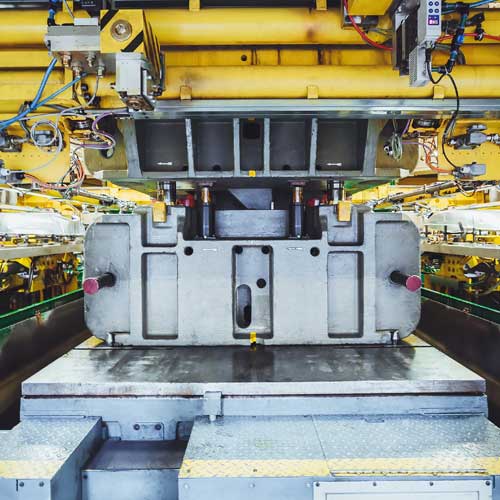Power Press inspections
A “Power Press” is defined in PUWER as a Press or Press Brake for the working of metal by means of tools, or for die proving, which is power driven and which embodies a flywheel and a clutch.
Power Presses are amongst the most dangerous machines used in industry that have caused many accidents over the years.
Accidents involving Power Presses are usually caused by trapping between the tools. These accidents often result in amputations or life changing injury. The cause is often found to be poor maintenance or setting of the press, its safeguards and the control system.
Legislation information
The Provision and Use of Work Equipment Regulations 1998 (PUWER98) was introduced to ensure safety when working with any work equipment, including power presses.
It applies to employers, self-employed and employees – the owners and users of work equipment. Regulation 32 of PUWER – The safe use of Power Presses, specifically sets out the requirements for the applicable machines including the requirement for a periodic thorough examination of the machine and its guarding system by an independent competent person such as Zurich Engineering, a UKAS accredited inspection body.
How can I ensure my Power Press complies with PUWER?
Our experienced team of Power Press Engineer Surveyors can help you achieve compliance with PUWER, firstly by identifying the type of clutch and brake fitted to the Power Press and completing an internal NDT and visual examination of the safety critical components of the clutch and brake.
Once this process is completed and any defects are remedied a full thorough examination can be completed by one of our Engineer Surveyors to ensure compliance with the requirements of PUWER.
What is the purpose of the Thorough Examination?
The purpose of the periodic Thorough Examination of these types of machine and their safeguarding systems is to detect and report deterioration that may affect the safety of persons, so that repairs or action can be taken in good time to eliminate or control the risk.
A complete visual inspection and functional test of the machine and its safeguarding systems is undertaken at 6 or 12 monthly intervals dependent upon the type of guarding fitted to the machine.
Deterioration may include wear, corrosion, cracking, vibration, overheating/burning of components or deterioration of any hydraulic, pneumatic or electrical system.
In addition, all guards and safety devices are functionally tested to ensure that they both operate correctly and prevent access to the dangerous moving parts of the machine. Where machines are fitted with active optical protective devices, a full stopping performance test is completed at 6 monthly intervals to ensure that the machine complies with current guidance.
Other types of machinery we examine under PUWER
Our experienced team of Power Press Engineer Surveyors also complete the examination of other types of machines and their safeguards that fall under PUWER these include:
- Hydraulic Presses and Press Brakes
- Paper Cutting Guillotines
- Metal Cutting Guillotines
- Woodworking Machines
- Injection Moulding Machines
- Rubber Moulding Machines
- Metal Working Machines
- Thermo Forming Machines
- Rubbish Compacting Machines
- Pneumatic and Hydraulic Baling Presses
- Photo Electric Devices
We also offer the following services through our Consultancy Services department
- Power Press Toolsetter’s Training Course.
- Prior to purchase NDT examination of the safety critical components.
- Prior to purchase Thorough examinations.

Online reporting
Access all your inspection activity whenever you need it, via Crimson, our online reporting tool.

Our accreditations
Useful inspection information
The term - 'Competent Person'
The Management of Health and Safety at Work Regulations 1999, (MHSWR) Regulation 7 (1) states that every employer shall, subject to paragraphs (6) and (7), appoint one or more competent persons to assist him in undertaking the measures he needs to take to comply with the requirements and prohibitions imposed upon him by or under the relevant statutory provisions and by Part II of the Fire Precautions (Workplace) Regulations The Provision and Use of Work Equipment Regulations 1998, (PUWER) Approved Code of practice (ACoP) states that ‘The competent person should have the necessary knowledge and experience'.
Zurich Engineering as a 'Competent Person/Body'
In order to comply with the approved codes of practice for the regulations under which plant and equipment is subject to periodic in-service inspections or thorough examinations, a Competent Person is likely to be a corporate body rather than an individual because of the necessary requirement to have access to a wide variety of technical expertise and specialist services such as non-destructive testing (NDT). One indication of competence is accreditation and certification. For inspection bodies, there are several indicators of competence and Zurich Engineering hold the following:
- UKAS accreditation - ISO17020 Type A inspection body.
- UKAS accreditation - ISO17065.
- Quality Management System Certification - BS EN ISO 9001.
- Trade Association (SAFed) membership.
- Compliance to SAFed Standard SS01 (assessed as part of Inspection Body accreditation).
Reporting status and defect code guide
Serious defects (AE)
This status indicates that a defect that poses (or could pose) a risk of injury to persons has been identified and that it must be reported to the enforcing authority. For most items, a defect that is required to be reported to the enforcing authority also poses an immediate or imminent danger to persons and the report will indicate this. For power presses, defects that need to be reported to the enforcing authority include those that do not pose immediate or imminent danger to persons. If the defect is not ‘immediate’, the report will indicate the date by which any rectification work should be undertaken.
Serious defects (AN)
This status indicates that a defect that poses (or could pose) a risk of injury to persons has been identified but that it does not require reporting to the enforcing authority. If there is immediate or imminent danger to persons, then the report will indicate this. If there is no immediate danger to persons, the report will indicate the latest date by which any rectification should be undertaken.
'B' defect (BD) or Other defect (in the case of power presses)
This status indicates that a defect has been identified but that, in the engineer surveyor's judgement, it does not pose a specific risk of injury to persons as defined in the respective regulations to which the item has been inspected. The defect should be assessed by the customer, as soon as reasonably practicable, and appropriate action taken if deemed necessary by the customer.
Deleted item (DL)
Indicates item has been removed from the schedule.
Not located (NL)
Indicates that an Engineer Surveyor has not been able inspect or thoroughly examine the item because the customer has not presented it for inspection or thorough examination and the engineer surveyor has been unable to locate or identify it.
Not available (NV)
Indicates that an item has been identified and located but we have not been able to complete an inspection or thorough examination because the item was not able to be inspected or thoroughly examined, e.g., out of service awaiting repair or not adequately prepared
OK
Indicates that an inspection took place and no defects were detected. However, the customer should view the reports for observations as these may provide useful information.
Customer advice (CA)
Indicates a Customer Advice, issued for important advice / informational purposes only.
Postponement (PD)
Indicates a Pressure item examination has been postponed in accordance with regulation 9(7) of the Pressure Systems Safety Regulations 2000 (PSSR)
General notes
We recommend that all reports of inspection and thorough examination are reviewed to ensure you are aware of the content.
Any item that has not been inspected by the due date on the current report of inspection or thorough examination should be taken out of service until the statutory inspection has taken place unless it has been postponed in accordance with regulation 9(7) of PSSR. Where defects have been identified and reported as requiring remedial action within a specified time, these should be rectified within the specified time period.
For all defects we recommend that the customer should review any relevant risk assessments and working procedures to ensure the continued safety of employees and other people that might be affected.
Managing statutory equipment can be difficult and needs tight control to avoid potential issues when equipment is used beyond its due inspection or thorough examination date. One way to control the use of equipment is to physically tag or “colour code” when it has been inspected or thoroughly examined and is safe to use.
Various types of colour coding can be used in different ways to distinguish when a piece of equipment is still safe to use and these options can be discussed with our teams
Whilst colour coding can be a cost-effective method of indicating the suitability of the equipment for further use, there are other options available for the control of equipment. Date stickers, date tags and rubberised tags are all potential options depending on the environment in which equipment is used, and Zurich Engineering are able to offer a number of options depending on your needs, so please speak to our teams to discuss.
More information

Engineering inspection
Find out about our other engineering inspection services, from lifting equipment to pressure systems

Engineering insurance
Zurich Insurance Company Ltd offer a wide range of engineering insurance covers for owned and hired-in plant and machinery

Engineering technical services
Find out more about our Technical Services offerings


